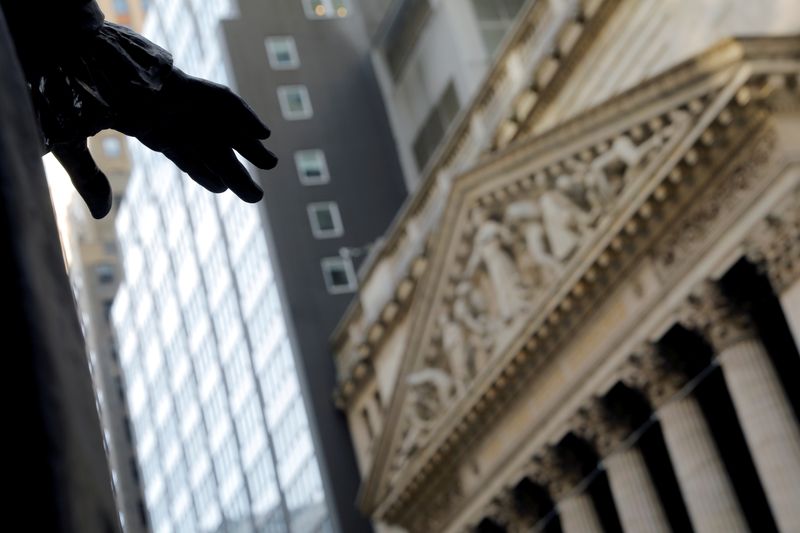
[ad_1]

© Reuters. FILE PHOTO: The hand of a sculpture of former U.S. President George Washington is pictured with the facade of the New York Stock Exchange (NYSE) in Manhattan in New York City, New York, U.S., January 28, 2021. REUTERS/Mike Segar
By Stephen Culp
NEW YORK (Reuters) – Wall Street bounced back with a broad rally on Thursday, recovering ground lost in the previous session’s steep sell-off as investors snapped up bargains while digesting the implications of a morphing pandemic.
All three U.S. indexes were green, with a bias toward value over growth, and economically sensitive smallcaps and transports outperforming the broader market.
The blue-chip Dow was on track for its best one-day percentage gain since Nov. 9, 2020, with Boeing (NYSE:) Co, providing the biggest lift.
“Obviously, there’s concern about Omicron but there’s a feeling that infections aren’t as severe as initially thought,” said Oliver Pursche, senior vice president at Wealthspire Advisors, in New York. “Second, economic data, particularly labor data, is coming out on the strong side.
As world governments scramble to determine how to respond to the emergent COVID-19 variant Omicron, the United States is set to require private health insurance companies to provide at-home tests, a policy expected to go into effect on Jan. 15.
The Omicron variant has spooked markets for about a week, hitting travel-related stocks particularly hard as a patchwork of new restrictions were enacted around the globe, but those companies were bouncing back in Thursday’s session.
The S&P 1500 Airlines and Hotel and Restaurants indexes were up 7.7% and 4.1%, respectively.
Jobless claims and planned layoffs data provided further evidence that employers are increasingly disinclined to hand out pink slips amid a tight labor market, the result of booming demand colliding with worker scarcity and low labor market participation.
Labor scarcity, combined with stubbornly persistent supply chain constraints, has helped erase the word “transitory” from the Federal Reserve’s inflation vocabulary as wages and prices continue to rise, and could very well translate into rate hikes coming sooner and faster than many had hoped.
“Should the Fed move rates up sooner than expected, while it could affect markets negatively in the short term, it gives the Fed room to act when the next recession nears,” Pursche added.
Market participants now train their gaze on the Labor Department’s hotly anticipated November employment report, expected on Friday.
The rose 688.29 points, or 2.02%, to 34,710.33, the gained 73.8 points, or 1.64%, to 4,586.84 and the added 126.91 points, or 0.83%, to 15,380.96.
All 11 major sectors of the S&P 500 were green, with financials enjoying the biggest percentage gain, with healthcare stocks up the least.
Boeing Co advanced 6.0% after China’s aviation authority gave its seal of approval the planemaker’s 737 MAX aircraft.
Kroger (NYSE:) Co surged 12.5% to top the S&P 500 after the grocery retailer raised its full-year sales and profit forecasts.
Consumer credit companies Visa Inc (NYSE:), Mastercard Inc (NYSE:) and American Express Co (NYSE:) all gained more than 4%.
Advancing issues outnumbered declining ones on the NYSE by a 2.38-to-1 ratio; on Nasdaq, a 1.46-to-1 ratio favored advancers.
The S&P 500 posted four new 52-week highs and 12 new lows; the Nasdaq Composite recorded nine new highs and 547 new lows.
[ad_2]
Source link